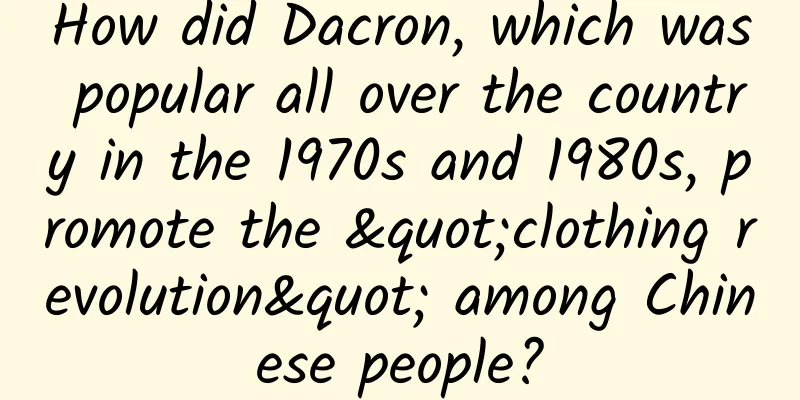How did Dacron, which was popular all over the country in the 1970s and 1980s, promote the "clothing revolution" among Chinese people?

|
I wonder how many people still remember "Dacron"? In the 1970s and 1980s, clothing made of this fabric was very popular. It could come in a variety of colors and was very durable and wear-resistant. These properties made it a hot commodity of that era. People at that time even felt proud to own a piece of Dacron clothing. However, Dacron's popularity was short-lived in the 1970s and 1980s, after which it suddenly disappeared and rarely appeared in the public eye. Today, most people have forgotten that it ever existed. So what exactly is Dacron, and why did it disappear after a brief period of popularity in China? Why did people like Dacron so much in the past? In fact, it is no accident that Dacron became popular in China. It can be said that its popularity was inevitable under the background of the 1970s and 1980s. At the beginning of the founding of New China, what people wore and used were mainly cotton products. Cotton is a natural fiber and relatively easy to obtain, but it grows on the land, which means that if you want to grow more cotton, you have to grow less grain. The competition between cotton and grain for land was a major conflict at the time. Compared with clothing, food was obviously more important, so cotton production was very limited. It is believed that in the 1950s, the per capita cotton cloth in China was only 4.5 meters[2]. It is also because of this that people had to use cloth coupons to buy cloth in that era. On the other hand, as a clothing fabric, cotton is very comfortable, but it is not very durable. In addition, the supply of fabric was very limited at the time, so people's clothes had various patches on them. Not only that, due to backward industrial production technology, cotton fabrics are easy to fade, so the cotton clothes people wore at that time were mainly dark in color and very gray. Dacron can solve all the pain points people have when wearing cotton clothes. It is very durable, not easy to fade (so the colors can be bright and varied), not easy to deform, and has a stable shape. The most important thing is that it is made of chemical fiber and does not need to grow from the ground, which has no conflict with eating. So, when Dacron appeared in China, even though it looks very "old-fashioned" now, it became popular in China in an instant and became the memory of a generation. How did Dacron come about? Why did it suddenly disappear? Dacron is a synthetic fiber, but now there are two types of synthetic fibers, one is synthesized using petroleum by-products as raw materials, and the other is synthesized using natural polymers or their derivatives as raw materials. Dacron belongs to the former, which comes from petroleum. Many people may not understand why oil can be turned into clothes. In fact, even now, if there were no fabrics produced from oil, most of us would probably have nothing to wear. Oil that has just been extracted is called crude oil, which is a complex mixture of hydrocarbons. People need to refine it before it can become commercial oil that we burn in our cars and ships. In the process of petroleum refining, various monomers are obtained, such as ethane, ethylene, etc. These monomers react with each other to produce high molecular polymers. Many of the tools we use now are actually made of these petroleum-derived high molecular polymers, such as polyethylene (PE), polypropylene (PP), polyester (PS), etc. You must have often seen these letter codes on the material lists of some industrial products. Dacron is also made from one of these polymers, called polyethylene terephthalate (PET)[3]. In industry, people melt this polymer and pass it through a device called a spinneret to produce fine fibers, which are called polyester fibers. Most of the fibers used in the world today are synthetic fibers (accounting for about 65%), and about 70% of synthetic fibers are polyester fibers. When it comes to polyester fiber, most people are probably familiar with it now. It is so widely used in our fabrics that as long as you pay a little attention to the material list of your clothes, you can basically see related words. However, it should be mentioned here that polyester fiber does not specifically refer to fibers made from PET - it is just the most commonly used type. Many people confuse PET and polyester fiber. In fact, PET is not only used for textiles, it also has an important application (accounting for about 30%), which is our plastic bottles. Picture: Some bottles are made of the same material as the clothes we wear So it is obvious that although the word "Dacron" rarely appears on clothes nowadays, the polyester fiber used to make it has always been in use. It's just that the spinning process and weaving process have undergone great changes, and the resulting fabric is no longer called Dacron. In fact, there is also a very famous fabric made of polyethylene terephthalate (PET), which is polyester. Many people probably have seen it on their clothing material list. Finally, let’s talk about the origin of Dacron, because I see many people confuse polyester with Dacron (including my reference 2), but based on my current understanding of the facts, this statement is also incorrect. Although both polyester and dacron are derived from polyethylene terephthalate, the two are indeed different in terms of craftsmanship. In fact, in the era of dacron, there were many fabrics derived from polyethylene terephthalate, but they had different names. The name Dacron actually comes from the chemical fiber brand name "Dacron" (transliterated) launched by DuPont, a notorious company in the American chemical industry. Dacron was not the first brand to use polyethylene terephthalate to make textile fabrics, but the United States' industrial advantages allowed it to become very large at the time and have a large export share. In our country, it first entered the Hong Kong market, and then entered Guangdong from Hong Kong, where it was transliterated as "quasi-liang". The word "liang" has a strong regional nature, and it is difficult for people from other places to understand its literal meaning. So when this fabric spread across the country, people in the north renamed it "decidedly cool" because of the cool feeling it gave when worn on the body. However, people soon discovered that this fabric was not cool in the summer - in fact, it was very non-breathable. It was just that this fabric was really good at the time, so it was renamed "daicang". This is the origin of Dacron. Before the 1970s, Dacron was 100% imported. So just imagine how cool it would be to wear a piece of Dacron clothing in that era. In the 1970s, Dacron really became popular, but at this time, Dacron was no longer purely imported. Most of it was probably domestically produced. Because in the early 1970s, China began to introduce complete sets of chemical fiber equipment from abroad, and the "Four Major Chemical Fiber" projects were put into production one after another. At this time, the output of Daqing Oilfield also began to soar - the problem of raw materials was also solved, and the output of Dacron increased suddenly. This is why it became popular in the 1970s and 1980s. However, I am not quite sure, and have not found relevant information, why China's own Dacron production later also used the name "Dacron". It may be because it was easier for people to accept at the time, or it may be because of the machines introduced at that time. Of course, it is also possible that Dacron was just a folk name that was then used commercially. In any case, the popularity of Dacron is directly related to the increase in China's own production capacity. In fact, it would make no sense if it was not popular in that era, because people at that time had no other choice except Dacron. Similarly, as our country's industry becomes more and more developed, Dacron, a relatively rough fabric made entirely of polyethylene terephthalate, has been difficult to meet the needs of the public, so it has gradually withdrawn from the stage of history. |
<<: Planting grass! Can reclaiming saline-alkali land and planting forage grass protect the ecology?
>>: Special: 30 pictures, farewell to 2023
Recommend
“A glass of wine a day keeps you alive until you are ninety-nine”, is that true?
People often say "a glass of wine a day, liv...
BMW X2 will debut in 2017, price may start from 240,000 yuan
The BMW X2 concept car was officially unveiled at...
5 steps for integrated marketing promotion across the entire network, this is the normal approach!
As the company develops and its market share incr...
New media operation skills: How to become a blogger with millions of followers?
Although the author is not a top blogger, the num...
Learn 4 topics about content marketing from Apple’s short video marketing
After having a WeChat official account , we all n...
Allergies, inflammation, skin diseases… Can we still take our children to the water park when it’s so “dirty”?
In the hot summer, the best way to cool off is to...
How many seconds is a femtosecond? Science: The "flying knife" is fast, accurate and ruthless, with a storage life of millions of years!
Laser is called "the fastest knife", &q...
Crow redeems emotions "Combo 3.0"
Crow Redemption Emotion "Combo 3.0" Res...
Jiang Ziya's little secret! Did the small token help King Wu defeat King Zhou?
Communication in war is an extremely important li...
Queqiao-2: How does the “postman” on the Moon “chat” with the Earth?
Did you know that the Earth and the far side of t...
New nanotechnology could make circuit boards as thin as paper
According to foreign media reports, Oregon State ...
Is it true that African mercenaries hold signs and shout? How much does it cost to produce an African mercenary advertising video?
8,000 kilometers away from China and with a 5-hou...
A 24-year-old boy contracted fungal pneumonia after smelling his unwashed socks! Are “stinky socks” so toxic?
Recently, a netizen named "Haiyan" from...
Apple has come up with a patent to make the iPhone waterproof
Apple is considering designing a waterproof iPhon...
Seed User Operation Methodology
The author shares his thoughts and experiences on...









